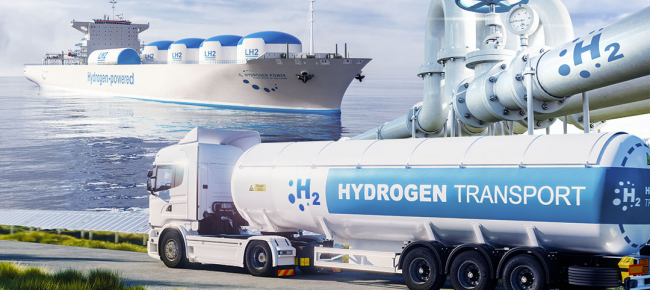Заголовок
Global Hydrogen Review 2022Created date
05 10 2022Executive summary
Hydrogen demand is growing, with positive signals in key applications
Hydrogen demand reached 94 million tonnes (Mt) in 2021, recovering to above pre-pandemic levels (91 Mt in 2019), and containing energy equal to about 2.5% of global final energy consumption. Most of the increase came from traditional uses in refining and industry, though demand for new applications grew to about 40 thousand tonnes (up 60% from 2020, albeit from a low base).
Some key new applications for hydrogen are showing signs of progress. Announcements for new steel projects are growing fast just one year after the start-up of the first demonstration project for using pure hydrogen in direct reduction of iron. The first fleet of hydrogen fuel cell trains started operating in Germany. There are also more than 100 pilot and demonstration projects for using hydrogen and its derivatives in shipping, and major companies are already signing strategic partnerships to secure the supply of these fuels. In the power sector, the use of hydrogen and ammonia is attracting more attention; announced projects stack up to almost 3.5 GW of potential capacity by 2030.
Considering policies and measures that governments around the world have already put in place, we estimate that hydrogen demand could reach 115 Mt by 2030, although less than 2 Mt would come from new uses. This compares with the 130 Mt (25% from new uses) that would be needed to meet existing climate pledges put forward by governments around the world so far, and with nearly 200 Mt needed by 2030 to be on track for net zero emissions by 2050.
The pipeline of projects for low-emission hydrogen production keeps expanding, but few are reaching FID
Much of the increase in hydrogen demand in 2021 was met by hydrogen produced from unabated fossil fuels, meaning there was no benefit for mitigating climate change. The production of low-emission hydrogen was less than 1 Mt in 2021, practically all of it coming from plants using fossil fuels with carbon capture, utilisation and storage (CCUS). However, the pipeline of projects for the production of low-emission hydrogen is growing at an impressive speed.
If all projects currently in the pipeline were realised, by 2030 the production of low-emission hydrogen could reach 16-24 Mt per year, with 9-14 Mt based on electrolysis and 7-10 Mt on fossil fuels with CCUS. In the case of electrolysis, the realisation of all the projects in the pipeline could lead to an installed electrolyser capacity of 134-240 GW by 2030, with the lower end of the range similar to total installed renewable capacity in Germany and at the upper end in all of Latin America. Meeting governments’ climate pledges would require 34 Mt of low-emission hydrogen production per year by 2030; a path compatible with reaching net zero emissions by 2050 globally would require around 100 Mt by 2030.
A significant portion of projects are currently at advanced planning stages, but just a few (4%) are under construction or have reached final investment decision (FID). Among the key reasons are uncertainties about demand, lack of regulatory frameworks and of available infrastructure to deliver hydrogen to end users.
Expanding electrolyser manufacturing capacity is critical to rolling out of hydrogen supply chains
Electrolysers using low-emission electricity are needed to produce low-emission hydrogen. Today, electrolyser manufacturing capacity sits at nearly 8 GW/yr, and based on industry annuncements it could exceed 60 GW/yr by 2030. This would be enough to meet current government targets for electrolysis deployment, but the build-out depends on government targets being translated into real-world projects beyond the current project pipeline. Although it is expected that the project pipeline will continue to grow over the coming years, there is a need to provide early support for projects to ensure that they reach FID and scale up.
Our analysis suggests that with today’s fossil energy prices, renewable hydrogen could already compete with hydrogen from fossil fuels in many regions, especially those with good renewable resources and that must import fossil fuels to meet demand for hydrogen production. There is of course uncertainty about how this plays out over the next few years. But if electrolyser projects in the pipeline are realised and the planned scale-up in manufacturing capacities takes place, costs for electrolysers could fall by around 70% by 2030 compared to today. Combined with the expected drop in the cost of renewable energy, this can bring the cost of renewable-based hydrogen down to a range fo USD 1.3-4.5/kg H2 (equivalent to USD 39-135/MWh). The lower end of this range is in regions with good access to renewable energy where renewable hydrogen could already be structurally competitive with unabated fossil fuels.
Large volumes of hydrogen could be traded by the end of the decade if barriers are addressed soon
The world’s first shipment of liquefied hydrogen from Australia to Japan took place in February 2022, a key milestone in the development of an international hydrogen market. Based on the export-oriented projects under development, an estimated 12 Mt of hydrogen could be exported annually by 2030, with 2.6 Mt/yr planned to come online by 2026. Nearly all of these export-oriented hydrogen project plans have been announced in the last two years, with most projects that have identified a hydrogen carrier chosing ammonia as the preferred option.
However, off-take and importing arrangements are lagging behind the scale of planned exports: only 2 Mt H2/yr has secured a customer or potential customer. Project developers and investors are facing high uncertainty in a nascent market and many governments have yet to implement specific hydrogen trade policies, which are necessary for the successful development of projects. International cooperation is vital to facilitate alignment and identify barriers that could slow the development of a hydrogen market.
The global energy crisis: an additional impetus for hydrogen?
The global energy crisis underscores the need for policy to align energy security needs with climate goals. Hydrogen can contribute to energy security by decreasing dependency on fossil fuels, either by replacing fossil fuels in end-use applications or by shifting fossil-based hydrogen production to renewable hydrogen. The development of an international hydrogen market can additionally add to the diversity of potential energy suppliers, enhancing energy security for energy importing countries in particular.
If governments implement ambitious policies to meet their climate pledges, hydrogen could help avoid 14 bcm/yr of natural gas use, 20 Mtce/yr of coal and 360 kbd of oil use by 2030, equivalent to more than today’s fossil fuel supply of Colombia. Heavy industry, heavy duty road transport and shipping offer the largest opportunities to deliver fossil fuel and emissions savings.
There are opportunities and challenges with repurposing infrastructure for the use of hydrogen
Repurposing natural gas pipelines for the transmission of hydrogen can cut investment costs 50-80%, relative to the development of new pipelines. There are projects under development to repurpose thousands of kilometres of natural gas pipes to 100% hydrogen. However, practical experience is limited and significant reconfiguration and adaptation will be necessary.
Governments, particularly in Europe, are considering repurposing liquified natural gas (LNG) terminals, though the opportunities depend on whether they will ultimately receive hydrogen or ammonia. Initial studies indicate that repurposing to accept ammonia can be possible at additional 11%-20% of the investment costs of a new LNG terminal. Repurposing LNG terminals for liquefied hydrogen faces greater technical challenges due to the much lower temperature needs, which limits the reuse of existing equipment. This has important cost implications. The LNG tank alone accounts for around half the cost of an LNG terminal investment and a newly built liquefied hydrogen storage tank to replace it can be 50% more expensive than a LNG tank. There is no experience yet converting existing LNG terminals to ammonia or hydrogen, rendering cost estimates uncertain. Uncertainty regarding the scale of future demand for hydrogen and its derivatives can limit the uptake of new terminals that can be hydrogen- or ammonia-ready.
As policy action intensifies, the focus must move to implementation
Governments continue to consider hydrogen a pillar of their energy sector strategies: nine new national strategies have been adopted since September 2021, bringing the total number to 26. Some countries are moving to the next step by implementing concrete policies, with a particular focus to support commercial scale projects for low-emission hydrogen production and infrastructure (e.g. the EU Important Projects of Common European Interest, the US Inflation Reduction Act and the German H2Global Initiative). However, there is still not enough policy activity for creating hydrogen demand, which is critical to secure off-take agreements. A lack of demand creation can hinder final investment decisions.
IEA policy recommendations to accelerate low-emission hydrogen production and use
Move from announcements to policy implementation: the focus of governments on defining the role of hydrogen in their energy strategies in recent years has helped industry understand the potential marketplace for hydrogen, and develop plans to incorporate hydrogen into technology and project portfolios. These technologies are ready to scale, but the hydrogen market is still nascent and its future evolution is uncertain, discouraging first movers from reaching FID. Governments need to implement policies to reduce risk and improve the economic feasibility of low-emission hydrogen projects.
Raise ambitions for demand creation in key applications: in existing hydrogen applications, the sharp increase in fossil fuel prices observed since the end of 2021 has significantly closed the cost gap between low-emission and unabated fossil-based hydrogen. However, investment decisions continue to be hindered by general uncertainty around the long-term development of energy prices. Policies to create demand for low-emission hydrogen are needed, using instruments such as auctions, mandates, quotas and requirements in public procurement. In new hydrogen applications, such policy action should be complemented by innovation and demonstration efforts, with a focus on sectors where hydrogen can both support decarbonisation and reduce dependency on fossil fuels, such as heavy industry, heavy duty road transport and shipping.
Identify opportunities for hydrogen infrastructure and ensure that short-term actions align with long-term plans: governments and the private sector need to look at opportunities to accelerate the development of hydrogen infrastructure, both in terms of new assets and repurposing existing natural gas infrastructure. For the latter, there are technical challenges, including for repurposing LNG terminals. As governments address immediate energy needs today, it is nonetheless important to carefully consider how new gas-related infrastructure may potentially support the future development of hydrogen in the context of climate ambitions.
Intensify international cooperation for hydrogen trade: the development of an international market for low-emission hydrogen will strongly depend on effective international cooperation. There are a number of areas where governments need to work together: developing a standard for emissions intensity of hydrogen production and transport, defining robust and workable regulations, and cooperation on certifications to ensure interoperability and avoid market fragmentation.
Remove regulatory barriers: the presence of a clear and stable regulatory framework must be balanced with a dynamic regulatory approach, calibrated to regular market monitoring. Actors involved in a hydrogen market need clear rules, but applying rigid regulatory principles in a nascent market could discourage investments. Improving regulatory processes, such as licensing and permitting, can help shorten project lead times. Governments should work to increase the efficiency and co-ordination of these processes without compromising environmental standards and public consultation. This should apply also to enabling infrastructure projects, including renewable generation capacities and CO2 transport and storage.
Resource: https://www.iea.org/reports/global-hydrogen-review-2022/executive-summary















